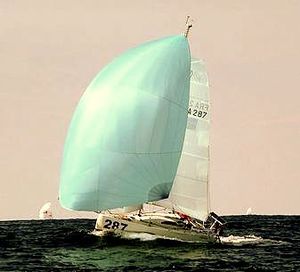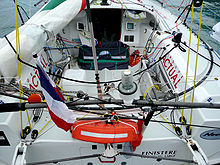- Mini Transat 6.50
-
Mini Transat 6.50 also known as Transat 650 is a solo transatlantic yacht race that starts in France and ends in Brasil covering over 4000 miles with a stop in the Madeira or the Canary Islands. The yachts are very small with respect to the race, and are sanctioned by the Miniclasse 6.50 organization. Miniclasse 6.50 closely monitors the craft but applies only minimal design restrictions such as length (6.5m), beam (3.0m), draft (approximately 2.0m), and material specifications[1], making the mini transat 6.50 an open design.The race runs on odd-numbered years, and is running right now (see news). Sailors must qualify by covering one of two specified 1000 mile courses along with having 1000 miles of ocean racing experience, much of it solo.
Contents
6.50 Class
The Mini 6.50 is very short for its intended use and is beamy being nearly half as wide as it is long. Its width carries to the stern, allowing the craft to plane as a fast motorboat does. Minis typically sail as fast, potentially reaching 25 knots. They have two connected rudders and a narrow steel or iron fin keel with a lead bulb at the end. The mast height is typically twice the Mini's length. They also have a retractable bowsprit that extends a spinnaker-genoa "kite" two or more meters beyond the bow. Mini's must be self-righting when capsized, and this is proved by pushing the end of the mast under the water while the vessel's hatches open.
There are two divisions: production and prototype. Production boats use approved designs and comparatively conservative materials[2]. The prototype division is more liberal with respect to dimensions, such as keel depth and mast height, and it allows for advanced technology such as "canting" keels and carbon-fibre masts. The prototype class is approximately 7% faster.
By far, the most successful mini design is the commercially produced Pogo 2 designed by Jean-Marie Finot of Groupe Finot (now Finot-Conq) in 1995. In 2010, California's Open Sailing USA began building the Pogo 2, under license, giving hope for substantial mini racing in the Western Hemisphere. Though considered "accessible" as an ocean racing class, a new Pogo 2 costs upwards of $50,000 (USD).
2011 race news
- Win: The second leg, and with it, the race, has been won by David Raison with his self-designed Teamwork Evolution (October 30, 2011). He beat the previous record for this leg by only 23 minutes. He sailed his mini 26 days, 3 hours, 9 minutes and 40 seconds at an average of 6.8 knots. He is pictured right in this photo after winning. He stated "what a joy to be here and to see you all! This has been the toughest race of all" (quote).
- Raison's mini is unusual in having blunt, scow-type, bow rather than a sharp one as every other mini has (photo). He said that he felt that he had to slow down his mini during parts of the race, yet continued gaining on the other minis. He commented that it may be a while before his design innovation reaches larger open classes.
- 2nd and 3rd: Thomas Normand (vessel unreported) and Bertrand Delesne sailing Zone Large followed Raison.
- Second leg: The second, much longer, leg stared October 13th and promised to be better suited to minis: down- and off-wind surfing. But within a few days (Oct. 15), the wind picked up causing at least 9 boats crippling damage, including to solar- and fuel-cells that shuts down the necessary auto-pilot as minis are solos. So, the list of DNFs could be upward of a dozen by now. Alarmingly, winds of 25 knots should not be crippling, as minis can go that fast. Fortunately there are no reported injuries or drownings, but a least a few dismastings.
- First leg: Sébastien Rogues sailing Eole Generation (prototype sub-class) arrived first in Maderia on October 4th averaging 5.4 knots, but Benoît Mariette sailing Odalys Vacances was the first stage winner for production boats. The winds were tricky for the first leg, and it was an upwind battle for the most part. (Minis are not upwind vessels, being miniatures of the other open classes that follow the trade winds around the world. They typically have a "pie slice" shape that makes the fall over towards the leeward bow giving a bad angle such as cat boats have, and they tend to slam violently into on-coming waves. Please note that this year's winner has a uniquely shaped vessel, see above.)
- Start: Charente-Maritime, France on September 25, with a stop in Madeira, and going on to Bahia, Brazil.
Sources
- Official news
- Blogs
-
- Scott Cavanough
- Pip Hare
- Stills
- Video
Race culture
There are no prizes and the Mini Transat is not necessarily considered a race for the win. Sailors are competitive yet mutually supportive during training and preparations, they tend to be closely grouped during the race, and a race completion is seen as a personal victory. Non-completion means, at very least, loss of the mini. The race is considered dangerous and there was a drowning during the first leg of the 2009 race. Racers typically sleep only 20 minutes at a time [3] and rely on computerized autopilot systems to keep the craft on course while they sleep. The class is considered an incubator for professional ocean racers as well as a test platform for larger ocean classes such as the Open 60 [4].
Other than the single-handed transatlantic crossing, there are a good many other races held for the class. In-between years see double-handed events, such as the Mini Fastnet, Mini Barcelona, Select 650 and Open Demi-Cle. The Transat years incorporate more single-handed events.
History
Bob Salmon developed the idea of a mini-transatlantic race in the late 1970s in England with the intent of promoting affordable offshore solo racing. It was partially conceived as a response to the trend for bigger and more expensive boats such as sailed in the OSTAR race that seemed to exclude ocean racing for sailors with moderate budgets.
The first Mini Transat started from the Penzance Sailing Club in 1977 and races have since run bi-annually on odd numbered years. There was a move to Brest, France in 1985, and since then, it has started in somewhere in France, such as Brittany, La Rochelle or, Charente-Maritime, with a stop in the Canary Islands or Madeira ending in the West Indies or Brazil.
Criticism
While the race is described as "mad," [5] Classemini has created rigorous trials, equipment, and inspection requirements to add sanity to the race. It might be said that the division within the class, production vs. prototype, unnecessarily divides the race. The mini Transat remains a largely French race with only about 30% non-French racers.
Another criticism is that the race is admitted to be a "test bed" for mechanisms to be used on bigger and far more expensive open classes. Reason for concern is that the race is potentially so dangerous, with one racer drowning in 2009, and many more in the past.
Sources
Boats, races, and sailors:
- Race roster (2011) - classmini
- Cruising at 25 knots during 2009 Trans At Race - Lucas Schroder video
- Transats built in US (Pogo 2 design) article Open Sailing USA, manufacturer
- 2009 La Rochelle before race - Histoire des Minis
Official and unofficial mini transat sites:
- Sanctioning body - Classmini 6.50
- Unofficial Transat 6.50 site - minitransat650
- Mini Transat 2011 forum - most languages
- Polish Transat site - transat650.pl
- Russian fan-site - open650.ru
- Hungarian Transat site - minitransat.hu
Categories:- Single-handed sailing races
- Recurring events established in 1977
Wikimedia Foundation. 2010.




